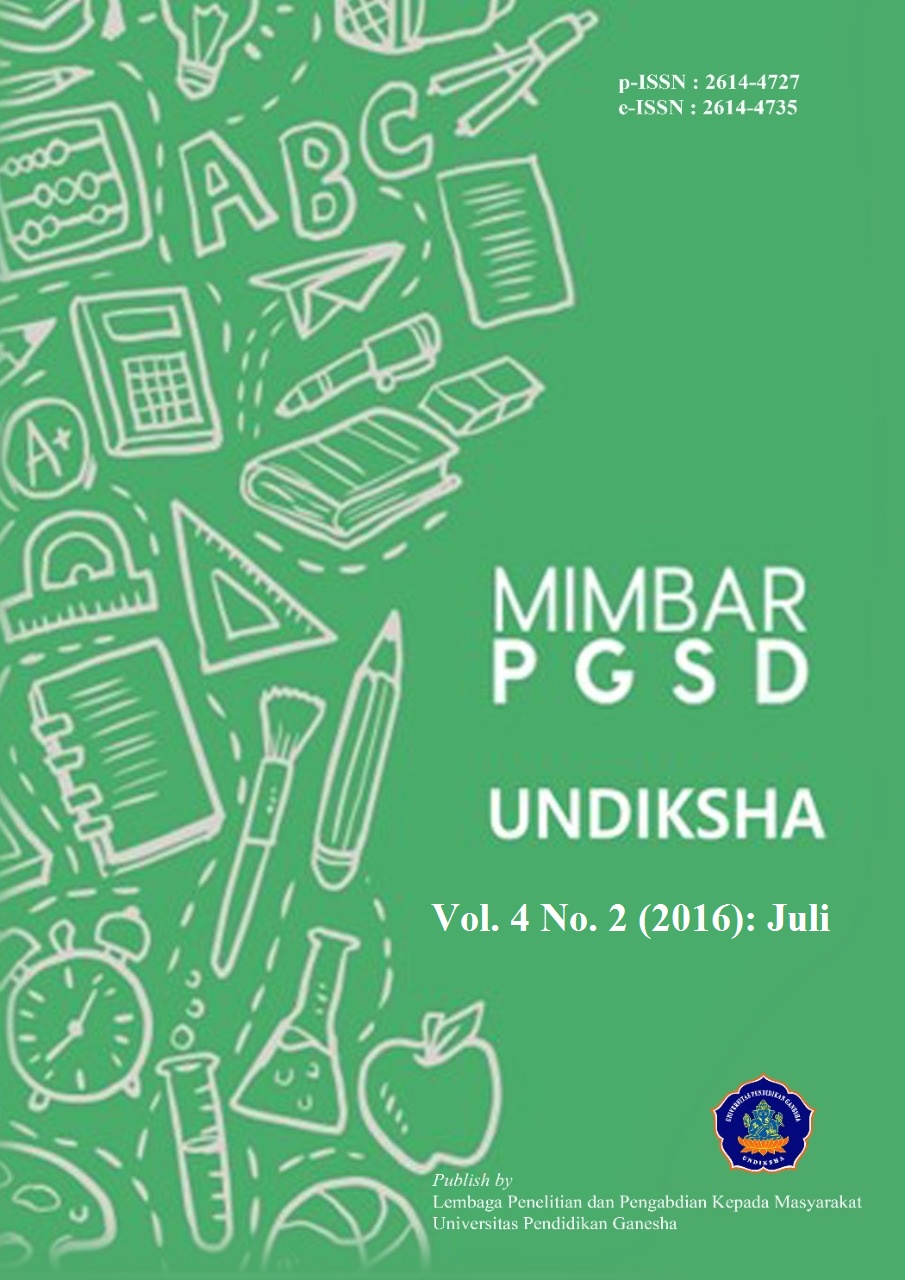PENERAPAN MODEL PEMBELAJARAN WORD SQUARE UNTUK MENINGKATKAN KEAKTIFAN DAN HASIL BELAJAR IPA SISWA KELAS V
DOI:
https://doi.org/10.23887/jjpgsd.v4i2.7650Abstract
Penelitian ini bertujuan (1) untuk mengetahui peningkatan keaktifan belajar IPA setelah penerapan model pembelajaran kooperatif tipe word square. (2) mengetahui peningkatan hasil belajar setelah penerapan model pembelajaran kooperatif tipe word square. Penelitian ini merupakan penelitian tindakan kelas dilaksanakan dalam dua siklus yang terdiri dari tahap perencanaan, pelaksanaan tindakan, evaluasi dan refleksi. Subjek penelitian adalah siswa kelas V SDN 2 Tukadmungga yang berjumlah 16 siswa. Untuk pengumpulan data menggunakan lembaran observasi keaktifan belajar dan soal pilihan ganda. Data dianalisis menggunakan teknik deskriptif kuantitatif. Hasil penelitian menunjukkan (1) terjadi peningkatan nilai rata-rata keaktifan belajar IPA siswa dari prasiklus sebesar 60,78 kategori kurang aktif menjadi 68,77 dengan kategori cukup aktif pada siklus I dan pada siklus II meningkat menjadi 80,24 dengan kategori aktif. (2) terjadi peningkatan nilai rata-rata hasil belajar IPA siswa dari prasiklus sebesar 54,37 dengan kategori sangat rendah, terjadi peningkatan pada siklus I sebesar 68,43 dengan kategori sedang dan dilanjutkan pada siklus II menjadi 82,5 dengan kategori tinggi. Berdasarkan hasil penelitian yang dilakukan dengan penerapan model pembelajaran kooperatif tipe word square dikatakan berhasil karena penelitian ini sudah mencapai kriteria keberhasilan yang sudah ditentukan sebelumnya yaitu 80 dengan kategori baik.Kata Kunci : Word square, Keaktifan Belajar, Hasil Belajar, IPA
The aims of this research (1) to determine the increase in activity of learning science after the implementation of cooperative learning model word square. (2) to increase learning outcomes after the implementation of cooperative learning model word square. This research is a classroom action research was conducted in two cycles consist of planning, action, evaluation and reflection. The subjects were students of class V SDN 2 Tukadmungga totaling 16 students. For data collection using observation sheet activity of learning and multiple choice questions. Data were analyzed using descriptive quantitative techniques. The results showed (1) an increase in the average value of the students' learning activeness IPA prasiklus of 60.78 into 68.77 is less active categories with category quite active in the first cycle and the second cycle increased to 80.24 with the active category. (2) an increase in the average value of student learning science outcomes pracycle at 54.37 with very low category, there was an increase in the first cycle of 68.43 with category and continued in the second cycle becomes 82.5 with the high category. Based on the results of research conducted with the implementation of cooperative learning model word square is successful because this research has reached the success criteria is predetermined that 80 good category.
keyword : Word square, activeness Learning, Learning Outcomes, Science
Published
2016-07-20
How to Cite
., M. W. P., ., D. N. T. R., & ., D. I. N. M. (2016). PENERAPAN MODEL PEMBELAJARAN WORD SQUARE UNTUK MENINGKATKAN KEAKTIFAN DAN HASIL BELAJAR IPA SISWA KELAS V. MIMBAR PGSD Undiksha, 4(2). https://doi.org/10.23887/jjpgsd.v4i2.7650
Issue
Section
Articles
License
Authors who publish with the Mimbar PGSD Undiksha agree to the following terms:
- Authors retain copyright and grant the journal the right of first publication with the work simultaneously licensed under a Creative Commons Attribution License (CC BY-SA 4.0) that allows others to share the work with an acknowledgment of the work's authorship and initial publication in this journal.
- Authors are able to enter into separate, additional contractual arrangements for the non-exclusive distribution of the journal's published version of the work (e.g., post it to an institutional repository or publish it in a book), with an acknowledgment of its initial publication in this journal.
- Authors are permitted and encouraged to post their work online (e.g., in institutional repositories or on their website) prior to and during the submission process, as it can lead to productive exchanges, as well as earlier and greater citation of published work. (See The Effect of Open Access)















